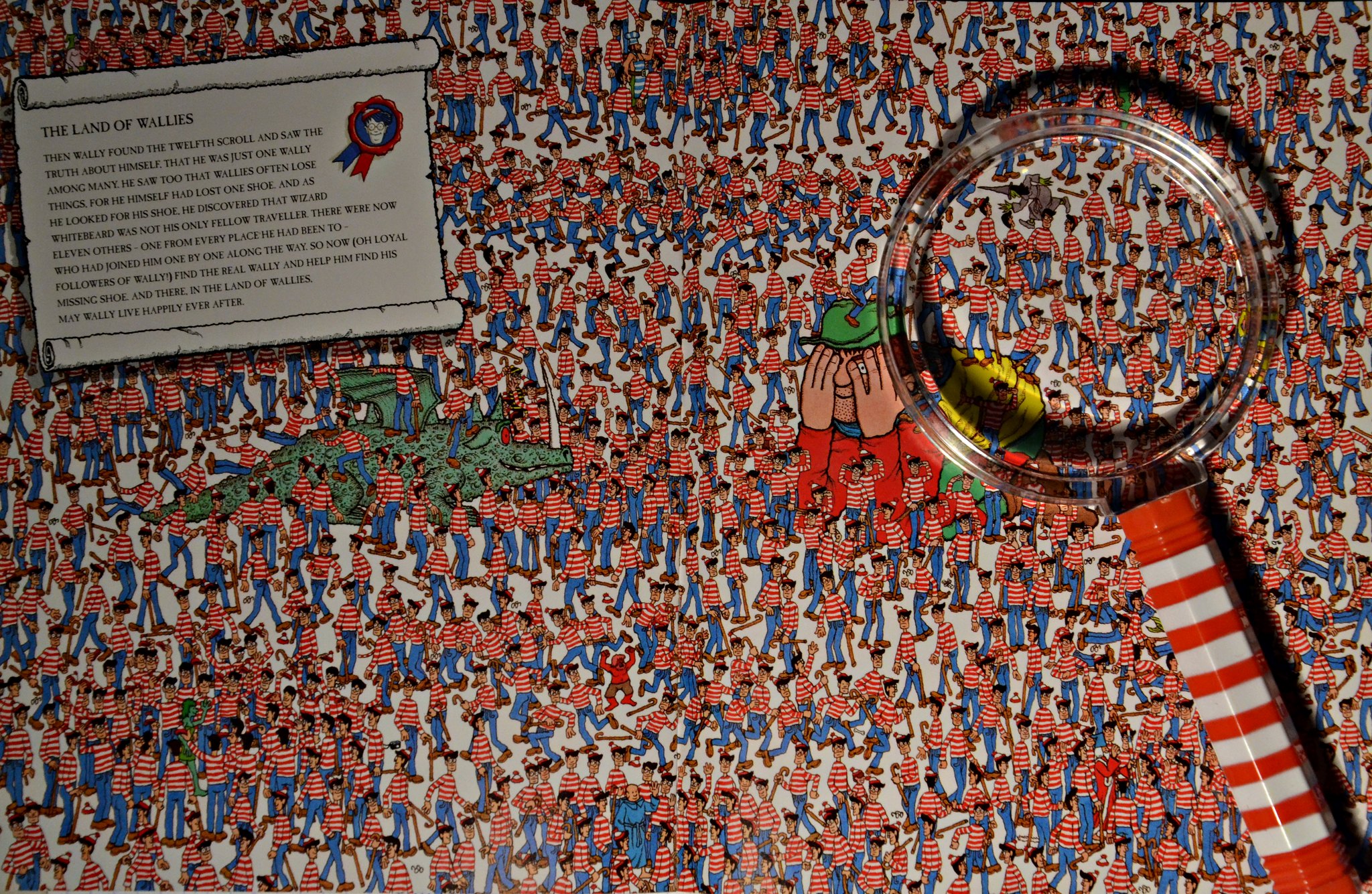
Where’s Wally? Tracing the life-trajectory of Antonio de Benavides. Part 1
Pretty much anyone born since the 1980s (and their parents) is familiar with the practice of looking for Wally. Since Martin Handford published the first book in the popular series in 1987, children all around the world have spent countless hours looking for an individual called by different names in different languages and parts of the world (Charlie in French, Walter in German, Ubaldo in Italian, Ali in Turkish, and, for some reason, Waldo in the US), but always dressed in iconic red and white stripes. In our way, us historians also spend hours looking for our own ‘Wallies’, searching for clues about where they were, what they were doing, who they were interacting with, and trying to understand the reasons behind their actions. Our ‘Wally’ this month was Antonio de Benavides, a Canarian soldier who fought in Flanders and the Iberian Peninsula, served as provincial governor in Florida, Veracruz and the Yucatan, and eventually returned to the Canary Islands to live out his retirement in Santa Cruz de Tenerife.
If finding Wally across the myriad scenes where he has been hidden over the last 32 years can be difficult, reconstructing Antonio de Benavides’s trajectory over 84 years across both sides of the Spanish Atlantic has been equally challenging. The clues are scattered across are range of different archives (civil, notarial, ecclesiastical, libraries’ special collections, etc), in various countries (Mexico, Spain, the United States), and at various administrative levels (municipal, provincial, and national). Finding Benavides has been made even more complicated by the current travel restrictions affecting many of the places where those archives are located. Consequently, this and our following post are dedicated to our experience of looking for Benavides online. As is often the case in Handford’s books, our task was complicated by an abundance of false clues, myths about our ‘Wally’ that have become perpetuated over time.
An ‘Illustrious Son’ of Volcanic Islands
In March 1795, the Sociedad Económica de Amigos del País of Tenerife, a private association devoted to the economic and intellectual development of the island, invited the public to participate in a competition to see who could write the best commemorative account of Benavides’s life. More than a year and a half later, the prize, an ounce of gold, was awarded to Bernardo Cólogan y Fallon, the 24-year-old grandson of Irish immigrants who had made a fortune in the wine trade.[1] Cólogan, however, was more interested in literature and natural history than in his family’s commercial enterprises.[2] In fact, six years later, Cólogan hosted Alexander von Humboldt in his house during the Prussian naturalist’s visit to Tenerife. From Cólogan, Humboldt obtained abundant information about the 1798 eruption of the Chahorra volcano, today’s Pico Viejo, the second highest mountain on the island. Cólogan went on to become a prominent figure in Canarian politics and society. Eventually, his biography of Benavides became quite influential too.
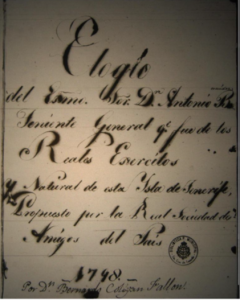
Frontpage of the manuscript version of Cólogan’s ‘Elogio del Exmo. Sor. Dn. Antonio Benavides’, Municipal Library of Santa Cruz, Tenerife, Ms. 62. (Our thanks to Dr Ana Pérez Álvarez for the image).
Although it remained unpublished until the mid-nineteenth century, Cólogan’s manuscript was often referenced by Canarian historians. Fortunately, for our purposes, while the original manuscript hasn’t been digitised, a printed version, published across eight issues of Santa Cruz’s newspaper El Eco del Comercio in 1857 is available online through the library of the Universidad de la Laguna. Thanks in large part to Cólogan’s account, an image of Benavides as an illustrious son of Tenerife had developed within a few decades of his death and persists to this day: streets in Santa Cruz and La Matanza still bear his name; in 2012, a series of events were organised to mark the restoration of his tombstone by the municipal council and the local historical association of Santa Cruz, the Tertulia amigos del 25 de Abril; and a couple of years later his life inspired a novel by Ceuta-born, but Tenerife-raised author Jesús Villanueva Jiménez.[3]
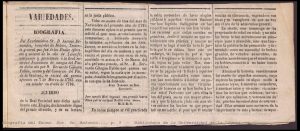
‘Biografía del Exmo. Sor. Dn. Antonio Benavides escrita por Dn. Bernardo Cologan…’ [Biography of His Excellency Don Antonio Benavides, written by Don Bernardo Cologan…], El Eco del Comercio de Sta. Cruz de Tenerife, numbers 578-581, 584-587, 1857.
Cólogan’s biography, written thirty years after Benavide’s death, is the earliest full account of our Wally’s life. It is also full of fantastic episodes that have been tirelessly repeated by local historians and history enthusiasts since the nineteenth century; they have even made their way into Benavides’s Wikipedia entry and a myriad other digital sources. During the last month, much of our work has focused on crossing these sources with archival evidence, some of it gathered before the onset of the pandemic, some found on digital repositories since, in an effort to corroborate or disprove the multiple threads that make up Benavides’s heroic shroud.
Cólogan tells us that his ‘hero’ -a man he describes repeatedly as ‘honest ‘, ‘virtuous’, ‘affable’, and ‘fearless’- was born in the small town of La Matanza de Acentejo, in Tenerife, on 8 December 1678 and we have no reason to doubt this. Although we have not been able to see the originals, we’ve seen transcriptions of Benavides’s baptismal and burial records which confirm this information. Cólogan waxes lyrically about our Wally’s childhood, the strength and ability he demonstrated from an early age, and retells a fanciful anecdote about how the young man impressed a military recruiter who helped him secure his father’s permission to enlist in the Spanish armies as a cadete and ship for Havana. This ‘fact’ is constantly repeated in later biographies, like Agustín Millares’s, which asserts that Benavides was in Cuba from 1699 to 1703.[4] Far from finding any evidence to corroborate this, all the information we have suggests Benavides did not cross the Atlantic westward before being appointed governor of Florida in 1717.[5]
Benavides’ own account of his services to the Spanish crown and official records of his military career suggest that our ‘Wally’ left the Canary Islands in 1692, as a fourteen-year-old alférez, to serve in the Spanish armies in Flanders. There, by 1703, he had reached the rank of teniente de infantería.[6] Thus, instead of rising meteorically through the ranks, in a short four-years of service in Cuba, it took Benavides eleven years of service in Flanders to get promoted just once. While this might seem trivial, it is quite significant. The Cólogan-Millares story suggests that Benavides was drafted into the army, aged 20, through his merits (and the promise the recruiting officer saw in him); moreover, by suggesting he enlisted as a cadete, effectively a noble soldier, his biographers hint at an aristocratic ancestry (or equate his physical skills with nobility).[7] By contrast, starting a career as alférez, the lowest officer rank, aged just 14 and lacking any previous military experience, suggests Benavides’s rank was probably purchased by this father; this would have been a common strategy for a family of well-off landowners without noble ancestry.
Benavides & the Fate of the Bourbon Spanish Empire
1703, however, was unquestionably a watershed in Benavides’s life. Cólogan claims it was then that his regiment travelled back from Cuba to Madrid, where he gained access to the court and met Philip V. The king then ‘came to know and esteem [Benavides], developing an affection for him he would feel from then onwards’. The archival records, again, tell another story, suggesting 1703 started very differently for Benavides. Still serving in Flanders, he fought in the battle of ‘Ecre’ (sic, perhaps for Ekeren) where he was ‘mortally’ injured in the head.[8] This, however, turned out to be a fortunate event as, within a few months, he had been transferred from his regiment to Philip V’s newly created personal guard: the guardias de corps.
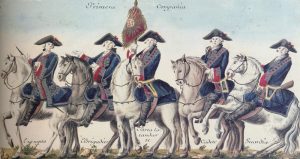
Soldiers of the 1st Company of the Royal Guard Corps during the reign of Philip V. Anne S. K. Brown Military Collection, Rhode Island, USA.
With his new unit, Benavides saw plenty of action during the War of the Spanish Succession (1702-1713) and received a series of rapid promotions. Having joined the corps as a guardia, a rank roughly equivalent to his previous one of teniente in the regular armies, by 1705 he had been promoted to sub-brigadier after serving in the campaigns in Portugal and Valencia. Between 1709 and 1710 he fought in the campaign of Catalonia, where Philip V often led his troops into battle, a practice that had earned him the moniker ‘the brave’.[9] Benavides’ actions at the siege of Tortosa, the battles of Zaragoza and Villaviciosa, and the siege of Campo Mayor, earned him a further promotion to the rank of brigadier (equivalent to capitán in the regular armies).
The battle of Villaviciosa, fought near Villaviciosa del Tajuña on 10 December 1710, is often considered a turning point in the war. It is also the background to, perhaps, the biggest myth associated with Benavides. Although the battle itself was a marginal Bourbon victory, it secured Philip’s conquest of Madrid and delivered a significant blow to the pro-Habsburg forces. Thus, it is not surprising that Cólogan would use this event to link the fate of the Bourbon dynasty to the bravery of his Canarian hero.
In a ‘courageous act deserving of our applause’, Benavides ‘noticed the king was risking his life with excessive daring’; he approached Philip and warned him the ‘splendid horse he rode’ made the monarch an easy target for the enemy, offering to swap mounts. The king allegedly accepted the offer and rode on, leaving Benavides to be shot shortly afterwards while riding Philip’s stallion. Thus, Cólogan would have us believe, Benavides saved the king and allowed the Bourbon dynasty to set root in Spain.
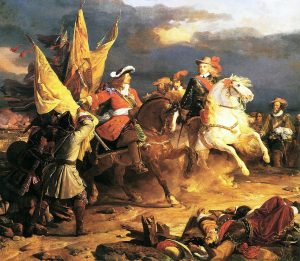
Jean Alaux. Bataille de Villaviciosa. 10 decembre 1710 (1836). Palace of Versailles. Galerie des Batailles.
This story is repeated uncritically in most biographies of Benavides, including some recent examples. Yet once again, there is no archival evidence it ever happened. Benavides’s record and his own account of his services make it clear he was present at Villaviciosa, but there is no indication he performed any particularly heroic actions during the battle; moreover, there is no indication of his being injured or receiving a battlefield promotion to the rank of coronel as Cólogan and others following him have suggested. In fact, we know that Benavides was not promoted again, to the rank of exempto (equivalent to that of coronel in the regular army), until August 1714.[10] And while we know that by then he had suffered ‘a serious accident which made it difficult for him to be constantly on horseback’,[11] there is no indication he received this injury in battle.
Thus, the often repeated claims that Benavides served in Cuba and saved the life of Philip V at Villaviciosa, the origins of which we’ve traced back to Cólogan’s biography, illustrate how the challenges historians face when retracing life trajectories come from more than lack of sources. Often, myths associated with the individuals we study can pose just as big an obstacle. We shouldn’t forget that while secondary literature from the eighteenth and nineteenth centuries may offer hints of where our ‘Wallies’ were hiding, they can also be deceiving. We shouldn’t lose sight of the fact that Cólogan’s biography was written with the explicit aim of celebrating an ‘illustrious son’, whose merits and achievements are presented as a reflection of his homeland: the myth of Benavides, the hero, playing a central role in the war of the Spanish Succession and the consolidation of the Bourbon dynasty masks a desire to see the Canary islands as central to Spanish history. Similarly, in the nineteenth century, authors like Millares saw in Banavides’s alleged Cuban sojourn a reminder of the Canaries’ close links to Spain’s last remaining colony. Thus, crossing a range of different sources —digital and in hard copy, primary and secondary, military and literary— is crucial to the process of tracking the life trajectories of historical subjects. Wally is not hiding in every corner of the internet coloured in red and white.
Notes
[1] (Guimerá Peraza 1979) A similar migratory and commercial processes has been identified for the Portuguese case of Madeira, see (Hancock 2009)
[2] (Real Torres 2015)
[3] (Villanueva Jiménez 2017)
[4] (Millares 1878, 120–36)
[5] AGMM Libro 88, f.86 v. – 87. “Grado de Caballería de Antonio Benavides” 19/09/1716
[6] AGS, GM, Exp.Pers., L.7; AGI, Panama, 172, R.V, Doc. 109
[7] (Andújar Castillo 2004, 61–74)
[8] (AGI, Panama, 172, Ramo V, Doc. 109)
[9] (Kamen 2001)
[10] (AGMM, Libro 88, ff. 86v-87)
[11] (AGI, Panama, 172, Ramo V, Doc. 109)
Bibliography
Andújar Castillo, Francisco. 2004. El sonido del dinero: monarquía, ejército y venalidad en la España del siglo XVIII. Madrid: Marcial Pons Historia.
Guimerá Peraza, Marcos. 1979. ‘Bernardo Cólogan y Fallon (1772-1814)’. Anuario de Estudios Atlánticos 25. pp. 307-355.
Hancock, David. 2009. Oceans of Wine: Madeira and the Emergence of American Trade and Taste. The Lewis Walpole Series in Eighteenth-Century Culture and History. New Haven: Yale University Press.
Kamen, Henry. 2001. Philip V of Spain: the King who Reigned Twice. New Haven: Yale University Press.
Miralles, Agustín. 1878. Biografías de canarios célebres: hijos ilustres de las Islas Canarias. Las Palmas de Gran Canaria: Imprenta de Francisco Martín González. http://www.mdc.ulpgc.es/u?/MDC,182731.
Real Torres, Carolina. 2015. ‘Del humanismo a la Ilustración: Bernardo Cólogan Fallon’. In Humanismo y pervivencia del mundo clásico. V. Homenaje al Profesor Juan Gil, ed. by J.M. Maestre Maestre, S.I. Ramos Maldonado, M.A. Díaz Gito, et al. Alcañiz: Instituto de Estudios Humanisticos / CSIC. pp. 2229–39.
Villanueva Jiménez, Jesús. 2017. La Cruz de Plata. Madrid: Libros Libres.

